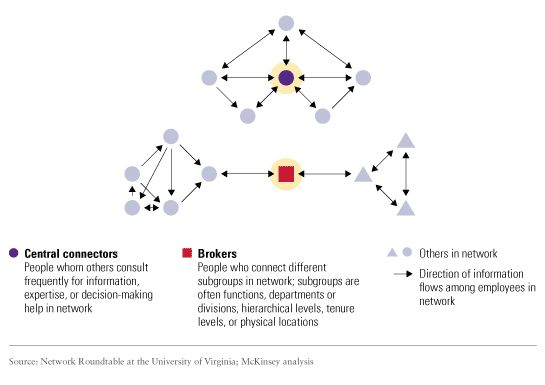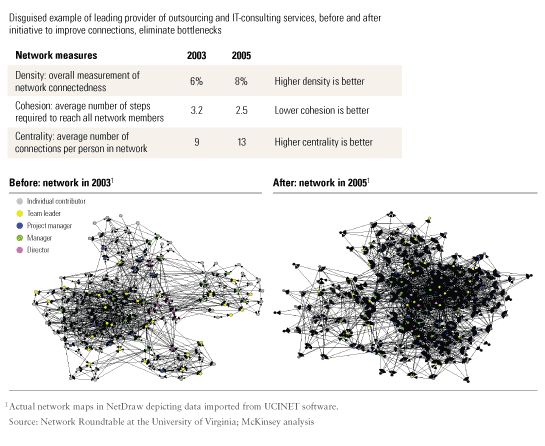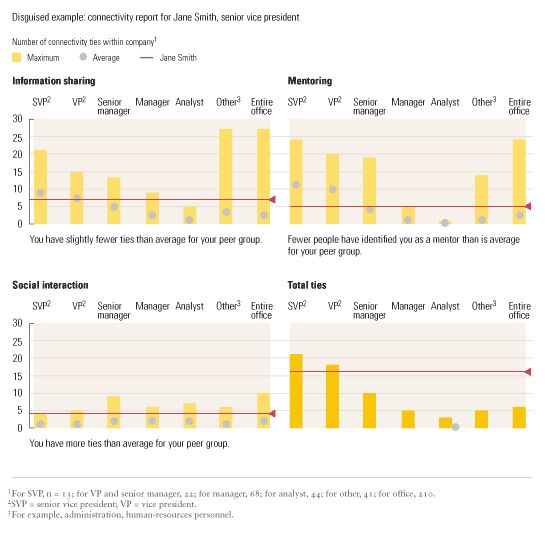A few years ago, the world’s leading designer and manufacturer of office products decided that it needed an organizational overhaul. Coordination across product lines was poor. Design teams collaborated ineffectively. Key personnel were remote from customers. The company responded in part by reorganizing its work space, creating an office-free “village” where designers and architects could mingle and collaborate and customers could visit easily. Proximity does matter for promoting collaboration, and the space was conceptually compelling and visually appealing. Yet it failed to spark meaningful innovation or closer relationships with customers. Four and a half years after the building opened, management decided to revamp the work space again.
This experience should be familiar to many businesses that respond to organizational dysfunction without fully thinking through its causes. An organization plagued by sluggish decision making might decide that decentralization is the remedy. A company suffering from poor communication, inflexibility, or an inability to pull together product offerings and expertise might try breaking down barriers that make functions or business units operate as silos. Yet as sensible as such interventions look on paper, they often yield disappointing results, so reorganizations, like rites of spring, come and go with surprising regularity, often without significantly boosting organizational effectiveness.
A key part of the problem is that the boxes and lines of formal organizational charts mask myriad relationships in networks that crisscross the borders of functions, hierarchies, and business units. These networks define the way work actually gets done in today’s increasingly collaborative, knowledge-intensive companies. Little wonder that total-quality-management projects and the reengineering of business processes—to take just two examples of organizational-change efforts that largely ignore these essential but invisible networks—fail at least two-thirds of the time.
In our experience, companies that invest time and energy to understand their networks and collaborative relationships greatly improve their chances of making successful organizational changes. Sophisticated approaches can map networks and identify the key points of connectivity where value is created or destroyed.1 A network approach can help companies to make change stick by working through influential employees, to focus on points in the network where relationships should be expanded or reduced, and to measure the effectiveness of major initiatives.
Identifying brokers
Before the office products company undertook the second overhaul of its work space, it conducted a network analysis that revealed a sparse and fragmented set of relationships, a surprising number of interactions based solely on reporting structures, a great deal of one-way communication, and employees who were completely isolated from the group that worked in the open area. In response, the company reevaluated who should “reside” in the officeless village, giving priority to employees who were both working on high-end, strategic projects and had knowledge that others found valuable. Especially important were “brokers,” who interacted frequently with external consultants, designers, and academics and then funneled information from them to internal teams.
Brokers who serve as bridges across a number of subgroups within networks are often quite influential.2 “Bridging” relationships uniquely position brokers to knit together an entire network and often make these interactions the most efficient means of gathering and disseminating information in a high-touch way. Brokers also tend to have the best perspective on what aspects of a reorganization will work across different subgroups and a high degree of ground-level credibility with people from disparate functions, locations, or occupations. What’s more, if management can persuade brokers to be early adopters and proponents of change, it can significantly boost the odds that a big transformational effort—involving a major cultural shift, postmerger integration, or the implementation of new technology—will succeed.
In our experience, it’s all too easy for a company to overlook its brokers because they tend to occupy the “white space” of an organization, and the sheer number of relationships they have may be small compared with those of other influential “connectors” to whom people frequently turn for information (Exhibit 1). In mergers, for example, companies often don’t know about brokers or they underestimate brokers’ potential importance to the merged entity. Recently, when a large pharmaceutical company undertook a friendly merger that required it to relocate 80 percent of its scientists, it carefully considered the knowledge it might lose from departures. Ultimately, it concluded that redistributing tasks among other employees or hiring new personnel could compensate for attrition. What the company failed to anticipate was the critical importance to the drug-development process of a few key scientists’ relationships with outside academics. Following the departure of two of the most richly connected scientists, these relationships deteriorated, and the merged entity’s innovation rate per scientist dropped significantly below each company’s premerger levels.
Brokers and connectors

Infusing organizational change with network understanding
By looking hard at networks before leaping into major change programs, companies can learn more than just who the brokers are in their organizations. When the office products company, for example, reviewed who was and was not collaborating, it quickly realized that the walls between workstations were too high and physical barriers among groups too common; also, the absence of permanent desks for certain workers made it difficult for colleagues to tap into their expertise. The benefits of correcting these physical features and moving the right people into the new, improved village included a 50 percent increase in connectivity among employees, more impromptu meetings, and better cross-pollination among groups. Customer visits also became more productive thanks to tighter connections among designers, product developers, and the salespeople conducting the tours.
The experiences of two for-profit companies and of the US Defense Intelligence Agency (DIA) demonstrate how insights from network analysis can illuminate a number of organizational imperatives: moving from a branch- and region-centric structure to a matrix one, breaking down silos, and combining globally dispersed personnel into a single, unified function.
Shifting from a branch- and region-centric structure to a matrix one
In 2005 a leading provider of outsourcing and IT-consulting services, with $1 billion in revenues and 10,000 employees spread across more than 70 offices around the globe, was experiencing organizational pain. Increased scale had created rigidities in the way the company made decisions and bundled and provided services. Redundant expertise, solutions, and technology were rampant across offices. Costs were ballooning.
The company’s leaders were convinced that an organizational focus on individual offices and regions was largely responsible for the growing pains. The consensus solution was moving to a client-oriented matrix combining industry-focused practice groups with a regionally focused sales organization, thereby creating a globally integrated business. Countless organizations have undertaken similar shifts, often with mixed results.
To make this reorganization effort address the problems more precisely, the outsourcing firm mapped and analyzed the networks that employees relied on in their work. A critical finding was that ten key executives—all but one a vice president or a director—had become organizational bottlenecks. Twenty-four to 51 employees regularly came to each executive for information, resources, or decisions—but many more could not get access. Shifting to a matrix structure without removing these bottlenecks would almost certainly have generated disappointment.
The company took two important steps to ease the pinch point. First, it implemented “expertise locator” technology, which helped people find answers to questions quickly without the need to move requests up the hierarchy. Second, management redefined the dollar thresholds at which lower-level employees could make pricing decisions and close deals. As part of this shift, the company created a team, one level below vice president, that exercised senior management’s proxy for pricing and for defining customer-specific solutions.
Another important finding: collaboration was actually fairly strong among offices within regions, where a number of employees served as “connectors,” but weak across regions. Promoting connections among the central people in each region would go a long way toward ensuring global coordination. The leader of applications services, one of the largest global groups, brought together central players from various regions—a move that built a more effective awareness of “who knew what” than would have been possible if the company had taken the steps typical in many matrix reorganizations, such as creating coordinating committees.
By focusing on eliminating bottlenecks and “connecting the connectors,” the company accelerated the shift to a matrix organization and made it more effective. Follow-up network analysis revealed that employees could find answers to questions more quickly and that collaboration was taking place across functions and regions. The proportion of employee connections with people in other functions, for example, increased by 13 percentage points. Anecdotally, these ties significantly improved client service, revenue growth, and the transfer of best practices. What’s more, the analysis highlighted a 15 percent increase in collaboration to support sales of $500,000 to $2,000,000 and a 9 percent increase for sales of $2,000,000 to $10,000,000.
Breaking down silos
For the outsourcing and IT-consulting firm, global growth and the need for collaboration across regions and business units were relatively new. By contrast, the DIA has been wrestling for years with an extraordinary collaboration challenge. The DIA, with more than 8,000 military and civilian employees around the world, is a major producer and manager of foreign military intelligence. Its task is to keep frontline officers, defense policy makers, and military planners informed while supporting US military planning, operations, and acquisitions of weapons systems. In response to Iraq’s August 1990 invasion of Kuwait, for example, the agency set up an around-the-clock crisis-management group to provide intelligence support for the forces assembled to expel the invaders. By the time the first Gulf War started, in January 1991, some 2,000 agency personnel were involved in the intelligence effort, with more than 100 on the ground in Kuwait.
Most DIA tasks involve some combination of collaboration inside the agency, coordination with other parts of the US Department of Defense, and interaction between the agency and the nondefense intelligence community. During the Cold War, intelligence sharing was methodical and routine: analysts at the DIA and other agencies composed reports and distributed them among departments for comment, review, and approval. Although largely appropriate when threats were well known and relatively predictable, this operating approach became problematic in a post-September 11 world characterized by shadowy and rapidly evolving threats. Information collectors and analysts working in relative isolation, both within and across agencies, had difficulty piecing together diffuse intelligence to generate valuable insights.3
In response, in 2004 the agency created a small group called the Knowledge Lab, tasked with breaking through the silos that obstructed collaboration. Before making any explicit organizational moves, the lab undertook a network analysis, which showed that some personnel (generally those with the longest tenure) were extraordinarily well connected and central to collaboration, while many newcomers were stuck on the periphery. Discussions with members of the analyst community also revealed a generational divide between longer-serving agency members, who were more wedded to methodical working approaches, and “Generation X” employees, who seemed more predisposed to flexibility and collaboration among groups.
Boosting connectivity between the brokers and the employees on the periphery would reduce the number of steps required for any individual in the network to get in touch with a colleague, increase the connectivity of the peripheral people by 20 percent, and promote the cross-generational sharing of approaches to work. So in the autumn of 2005, the Knowledge Lab established a structured mentoring process, including “first-meeting protocols,” to help brokers and peripheral people connect in ways that had value for both. After one year at the agency, “Joan,” for example, had a poor understanding of how it worked. Then her mentor gave her a sense both of how everyone’s jobs fit together and of some important but tacit cultural norms—for example, how to challenge authority effectively and how to reconcile narrow, organization-specific goals with the agency’s strategic priorities. Over time, the relationship helped Joan to execute her role better and to navigate the agency’s power structure and informal networks. For the mentor, passing on experience helped boost Joan’s morale, and getting to know her provided a valuable window into the mind-sets of younger analysts.
One by one, these mentoring relationships broke down barriers that had imposed organizational rigidity and inhibited collaboration (see sidebar, “Improving the performance of organizations one person at a time”). An assessment conducted in 2006 revealed that as a result of the enhanced network, employees had collaborated in and benefited from 235 new relationships (a 14 percent increase), that the networks of peripheral people had expanded significantly, and that the number of people leveraging the expertise of newcomers had tripled—the result, in no small part, of the legitimation and introductions they received from their well-placed mentors. In general, network-oriented mentoring efforts such as the DIA’s are a powerful means of integrating new people and improving retention rates.
Surveys showed that the agency’s efforts had not only facilitated the flow of information but also promoted cultural change. Network participants felt far more energized in collaborations with colleagues, an index measuring overall progress toward a more decentralized and flexible culture rose by 18 percent, and the gap between the perceived and desired work environment had shrunk substantially in the eyes of both management and employees. To reinforce cultural change, the agency established coaching programs promoting flexibility and collaboration, celebrated such values, and recognized them in performance assessments. By working through the contours of the network, the Knowledge Lab made significant progress toward transforming the DIA without the effort, expense, and risk of a major organizational restructuring.
Combining dispersed personnel into a single function
Another common goal of reorganizations is bringing together employees who perform related tasks but are dispersed in different regions or businesses. When support functions—such as accounting, finance, human resources, IT, or purchasing—are largely duplicated across geographies, consolidation enables corporations to achieve economies of scale while sharing best practices and expertise globally.4 Network analysis can make global functional networks more transparent, thereby revealing opportunities for integration and highlighting well-functioning relationships that a company should avoid disrupting.
The world’s largest engineering consultancy, with roughly $1 billion in sales and more than 5,000 specialists in 36 countries, undertook such an effort in 2003. Having grown through numerous mergers, the firm lacked consistent global processes and allowed business units and regions to operate autonomously. As a step toward better integration, it decided to consolidate its IT function—previously divided among six autonomous regional operations in Asia, Europe, and the United States—into a global department that would provide better service at a lower overall price. (Leveraging less expensive labor in India and New Zealand for networking and application development, for example, would reduce costs.) The key to the success of this new department, comprising 185 people in 27 offices and 11 countries, would be collaboration, which previously had been sorely lacking, so that internal customers paid different prices, got software and hardware with different kinds of functionality, and received different levels of service.
Network analysis highlighted a number of issues that couldn’t be solved solely by creating a unified organization and governance structure. Information sharing across geographies was limited not just because of the former autonomous structure but also because of the firm’s hierarchy: experts at its lower levels were communicating with superiors rather than with colleagues across the organization, whose knowledge might have proved useful. Not surprisingly, network connections clustered around several people who had become bottlenecks, and awareness of colleagues’ expertise was very low. Many of the people who were now expected to work together seamlessly had never even exchanged e-mails, let alone met in person.
The IT department decided to support the reorganization in three ways. First, it improved overall department-wide communication, partly by augmenting the travel budget to facilitate face-to-face meetings and also through frequent newsletters, staff meetings, and team-building activities. Second, it created IT knowledge communities in major expertise areas to encourage collaboration, the sharing of expertise, and the development and dissemination of global best practices. Third, it created several new project-management teams that cut across traditional geographic and business unit boundaries and focused on a few key functionwide initiatives, such as platform standardization.
By 2005 the IT function was operating in a truly global and integrated way. A follow-up network analysis showed dramatic improvements in connectivity (Exhibit 2) and highlighted significant time savings and the creation of economic value through collaboration across the firm’s former geographic and business unit lines. (The top eight contributors alone saved more than $1 million worth of time for colleagues in other regions.) Managers across the organization still use network analysis as a tool for identifying opportunities to improve operational effectiveness through communication and collaboration. In our experience, network analysis can be a useful indicator of progress in organizational-change efforts generally.
A more robust network

Executives contemplating a reorganization shouldn’t focus on formal organizational structures so much that they ignore informal communication channels and opinion leaders. By understanding the networks that employees use to get work done, executives leading organizational-change efforts can harness, rather than bump up against, the power of invisible but highly influential webs of relationships.

